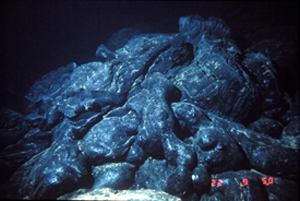Submarine Ring of Fire 2007

NOAA continued a multi-year series of discovery missions to undersea volcanoes and hydrothermal vents associated with the Submarine Ring of Fire, a large but virtually unexplored province in the Pacific where the Earth's tectonic plates are being forced below the Earth's crust. Accomplishments include discovery of abundant flows of both gaseous and liquid carbon dioxide (CO2) from the seafloor, which will provide a natural deepocean laboratory for studying ocean sequestration of this greenhouse gas. Regionally, large volumes of CO2 are affecting the acidity of the water column and the amounts and cycles of CO2 in seawater.
Newly discovered hydrothermal venting is producing mineral deposits likely to contain ore-grade concentrations of precious metals. Because the Mariana Arc hydrothermal fluids are very different than those associated with seafloor spreading centers, a large variety of apparently unique ecosystems have been discovered. The biotechnical and pharmaceutical value of these organisms is under study.
The New Zealand American Submarine Ring of Fire 2007 expedition will take us to Brothers submarine volcano, a site of vigorous geothermal activity north of New Zealand along the Kermadec Arc. We will explore Brothers in great detail using the state-of-the-art autonomous vehicle ABE. This expedition will mark the most comprehensive exploration of this type of submarine volcano to date. We will also be exploring some newly mapped deep rifts southwest of Brothers. The R/V SONNE will carry a team of 26 scientists and engineers from New Zealand, Germany and the U.S. to conduct these explorations. In addition, a new remotely operated vehicle will be used for seafloor explorations during the latter part of the expedition if successfully tested by our German partners.

 Deep Sea Crabs
Deep Sea Crabs